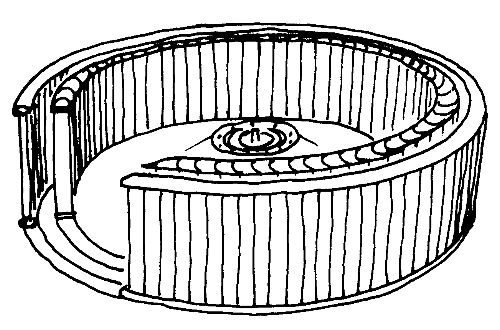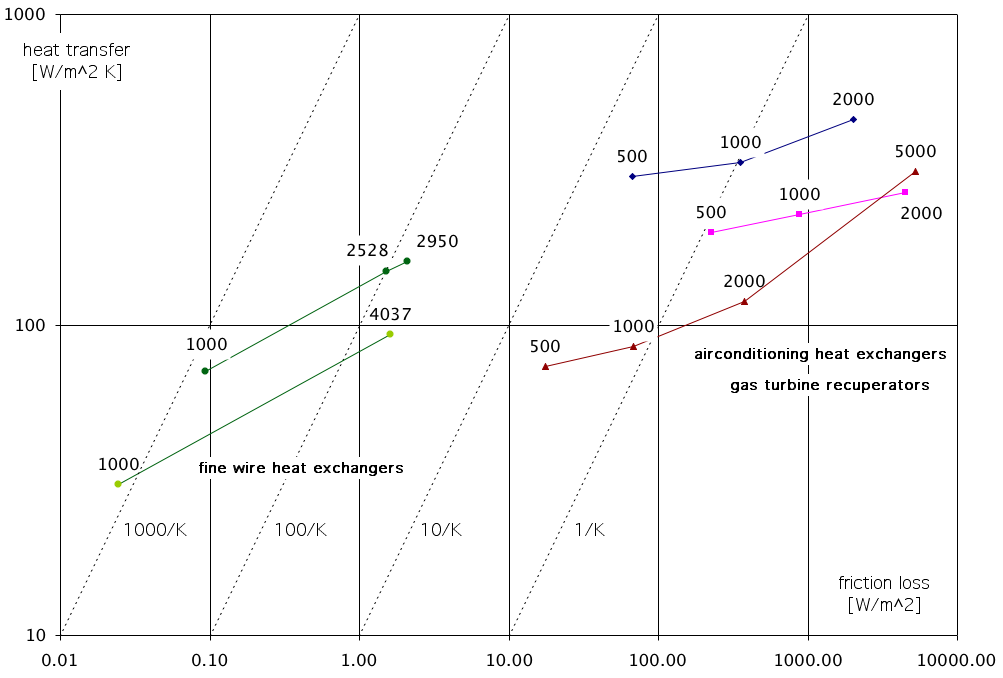

A slowly turning fan drives air (typically 500 liters per second) through a maze of copper fine wire gauze, woven around water carrying copper capillaries: a fine wire water-to-air heat exchanger. The result is one million 100µ Ø, 6 mm long copper fins that transfer heat ten times better than a typical central heating radiator. The performance can be described with the following formulae, where D = diameter fan in m; n = speed of fan in RPM:
| Heat transfer | 8 × D2 × n 0.8 | W/°C |
| Fan power (Pm) | 3×10-5 × D4 × n3 | W |
| Noise level | 20 × log Pm + 28 | dB(A) |
| Cost in series of 1000 | 300 × D | Euro |
Example: A fan with a diameter of 60 cm and a speed of 100 RPM will have a heat transfer capacity of 100W/°C, needs a mechanical power of 4W, has a noise level of 40 dB(A) and costs 180 Euro.
We are constructing a manufacturing unit near Moscow, which will be ready in 2008. The fans from this unit will have a diameter of 510 mm, maximum speed 250 rpm, electric power 60 W max., maximum heat transfer capacity 200 W/m2K. The photo hereunder gives an impression. This fan is OK for heating or cooling one room with a temperature difference of 5 K.

The air friction along the cloth, with comparable heat transfer of is compared in the graph below from Kayes & London, Heat exchangers. We see that with the same Reynolds number and coefficient of heat exchange, the friction is about 2 orders of magnitude lower. This is also the reason why the noise level is much lower.

Using Fiwihex heat exchanger fans, rooms and working spaces can be cooled with ground water that is only about 3 to 5 degrees cooler than the desired room temperature. In The Netherlands, ground water is normally about 12 °C, so one 100 W/°C Fiwihex ceiling fan cool a room to 20 °C with a power of (23-12)*100 = 1100 Watt. This is about the power (3750 BTU/hr) that a portable air conditioner can deliver. We can, for instance, when we need this 100 W/°C = 8*D2*n0.8, choose a Fiwihex fan with a D of 60 cm. The speed n becomes then (2000/(20-12)/8/0.62)(1/0.8) = 84 rpm, the mechanical power becomes 3*10-5*0.64*843 = 2.3 Watt, and the noise level becomes 20 log 2.3 + 28 = 35 dBA. This is a level of noise that is so low that it is never reached inside a city environment. The fan and water circulation pump will use about 60W of electricity, this has to be compared with 400W for a typical air conditioner.
When an existing heating net has a temperature range of 120-80°C, a doubling of the number of connected houses can be reached with Fiwihex ceiling fans. With a return temperature of 40°C, a set of fans of total capacity of 220 W/°C can heat a house to 22°C with a power of 4000 Watt, which is enough for the coldest week in a year. Four fans with 40 cm diameter and 75 rpm, mechanical power 0.3 W. The noise level is 18 dBA per fan. This is inaudible. The central combined heat & power station can increase its electric efficiency and output because the cooling water is colder.
The Fiwihex Heat exchangers are so powerful that heat
extraction from the outside air is now an economic possibility, when no ground
or surface water is available.A
Coefficient Of Performance of 6 is
attainable as a mean over the Dutch heating season (inside temperature 20°C,
outside 4.8 °C) with the following configuration:
2*1000 W/°C Fiwihex propane-to water heat exchangers; 2x500 W/°C Fiwihex fans and a standard shop display refrigeration compressor. The heat pump stops during electricity peak hours when the heat storage system has been installed. When (ground)water as a heat source is available, the COP rises
to 8. These heat pumps are now consumer-installable, with no-pressure,
low-temperature water circuits that can be made of plastic tubing. More about the COP of heatpumps...
For demand-side management, homes with Fiwihex heat exchanger fans can be fitted with a daily Glauber's salt heat storage so that their heatpumps can be switched off during peak demand. The house can be heated with low-tariff electricity.
The excess heat that normally has to be vented away by opening roof windows in the hothouse, can now, with Fiwihex heat exchangers and closed roof windows, be transferred to ground water under the hothouse. This heat will be available in winter to heat the hothouse with the same heat exchanger. A fan and circulation pump use only 60 W.
With a low-pressure drop water-to-air heat exchanger, a solar panel can be built that has almost no thermal mass and contains only 40 cc water per m2. This solar panel stops working as the sun does not shine, because the heat transfer is based on natural convection to a Fiwihex heat exchanger at the top. Combined with Fiwihex heat exchanger fans in the house, and with about 40 m2 of sun roof and shallow ground water storage, the house can be heated all year round. Ground water storage comes only in the economic reach for small systems when Fiwihex exchangers are used, because these can work economically with the small temperature ranges that can be realized with ground water use.
When Fiwihex heat exchanger fans are used for cooling, the air around the food is not cooled below its dew point, so relative humidity can stay at 80% and unpackaged food will not dry out.
Feedback on content: eur@fiwihex.com Feedback on layout: webmaster@fiwihex.com Last updated on May 22, 2006